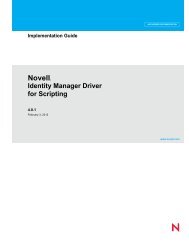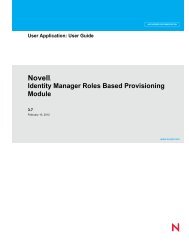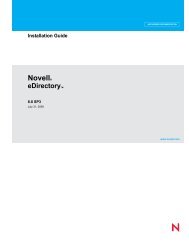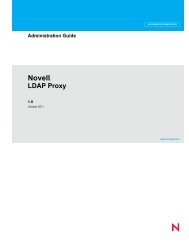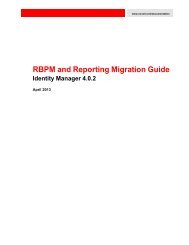Identity Manager 4.0.1 ID Provider Driver Implementation ... - NetIQ
Identity Manager 4.0.1 ID Provider Driver Implementation ... - NetIQ
Identity Manager 4.0.1 ID Provider Driver Implementation ... - NetIQ
You also want an ePaper? Increase the reach of your titles
YUMPU automatically turns print PDFs into web optimized ePapers that Google loves.
Parameter Default Value Description<br />
LDAP Port 636 The TCP port that the LDAP server listens on.<br />
The value is usually 389 for non-SSL<br />
connections and 636 for SSL connections.<br />
Use SSL True Specify whether or not you want to use SSL.<br />
Always trust True Specify whether or not you want to trust all<br />
servers. If this option is set to True, the <strong>ID</strong><br />
provider trusts all LDAP servers even if the<br />
server certificate is untrusted.<br />
Policy Container DN<br />
LDAP DN for the policy container<br />
under the driver object. For<br />
example cn=id-policies,cd=idprovider,cn=driverset1,dc=idm,d<br />
c=services,dc=system.<br />
Specify or browse to the DN of the policy<br />
container in your tree. The policy container<br />
can only be created under the <strong>ID</strong> <strong>Provider</strong><br />
driver.<br />
Client Options<br />
The client options are for the <strong>ID</strong> <strong>Provider</strong> clients. For more information, see Chapter 5, “Configuring<br />
<strong>ID</strong> Clients,” on page 23.<br />
Parameter Default Value Description<br />
Client name <strong>ID</strong>-<strong>Provider</strong> <strong>Driver</strong> This is the name the driver uses when it acts as an <strong>ID</strong><br />
client and requests and <strong>ID</strong> from the provider. This is<br />
useful for tracing and if access control is enabled on any<br />
of the <strong>ID</strong> policies.<br />
If access control is enabled, a list of <strong>ID</strong> client names can<br />
be specified that are allowed to obtain an <strong>ID</strong> from the<br />
policy. If the client name associated with the request is<br />
not in that list, the provider does not issue an <strong>ID</strong>.<br />
<strong>ID</strong> Generation Map workforce<strong>ID</strong>=wfid Provide a comma-separated list of attribute=policy<br />
pairs.<br />
For example, workforce<strong>ID</strong>=wfid,unique<strong>ID</strong>=uid. This<br />
example configures the driver to request <strong>ID</strong>s from the<br />
wfid policy and stores them in the workforce<strong>ID</strong> attribute<br />
whenever a new object is created or whenever<br />
someone tries to change this attribute.<br />
Similarly, <strong>ID</strong>s from the U<strong>ID</strong> policy are used from the uid<br />
attribute. The driver only issues <strong>ID</strong>s for any attribute if<br />
that attribute and the object class holding the attribute<br />
are in both the Subscriber, Publisher, Filter, and are set<br />
to synchronize.<br />
Attribute names must be in the <strong>Identity</strong> Namespace (not<br />
LDAP) and must be case-exact.<br />
Server Options<br />
These options allow you to set up clients other than the <strong>ID</strong> <strong>Provider</strong> driver by using Java Remote<br />
Method Invocation (RMI). It also allows you to set <strong>ID</strong> <strong>Provider</strong> trace level.<br />
16 <strong>Identity</strong> <strong>Manager</strong> <strong>4.0.1</strong> <strong>ID</strong> <strong>Provider</strong> <strong>Driver</strong> <strong>Implementation</strong> Guide




